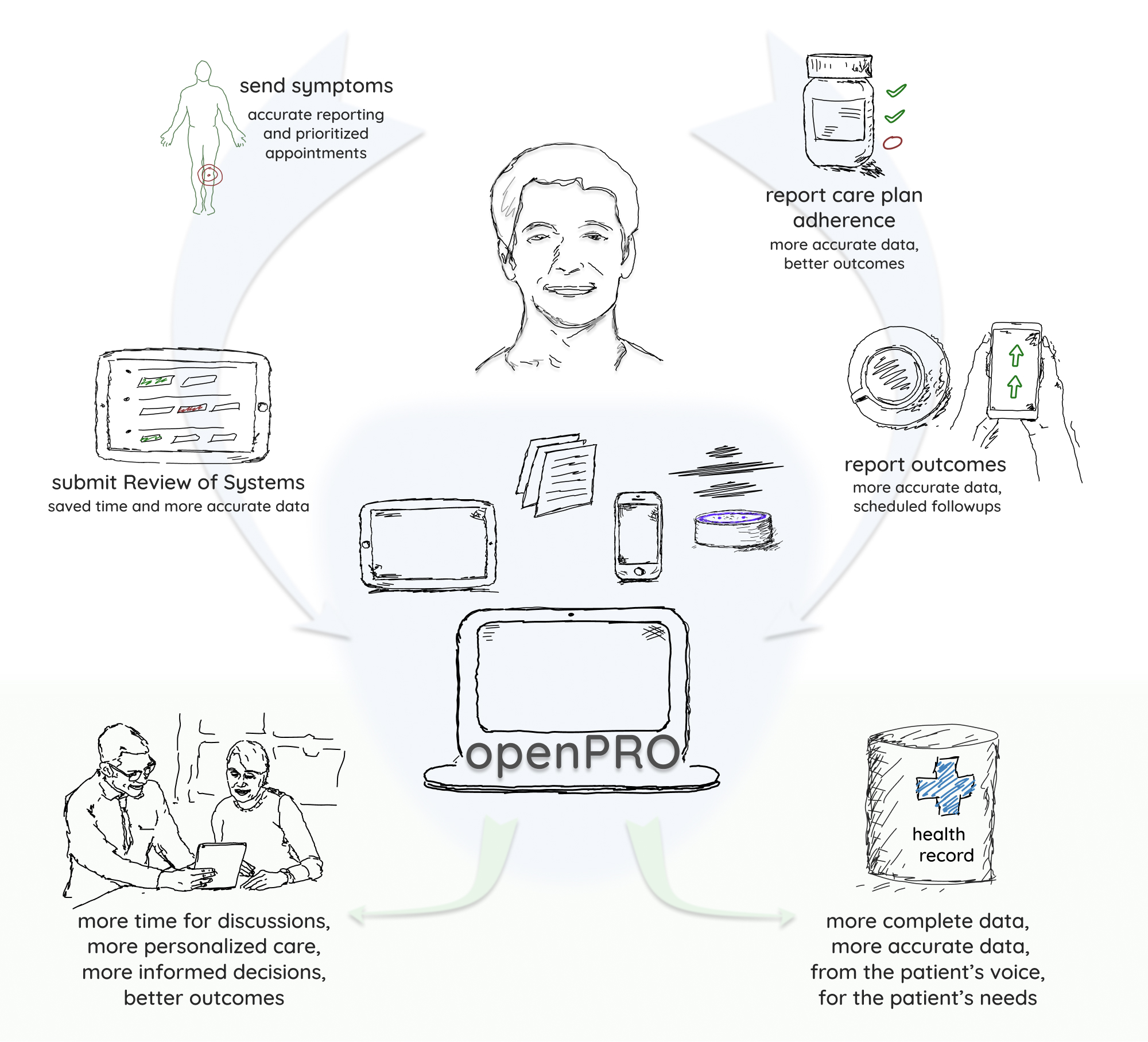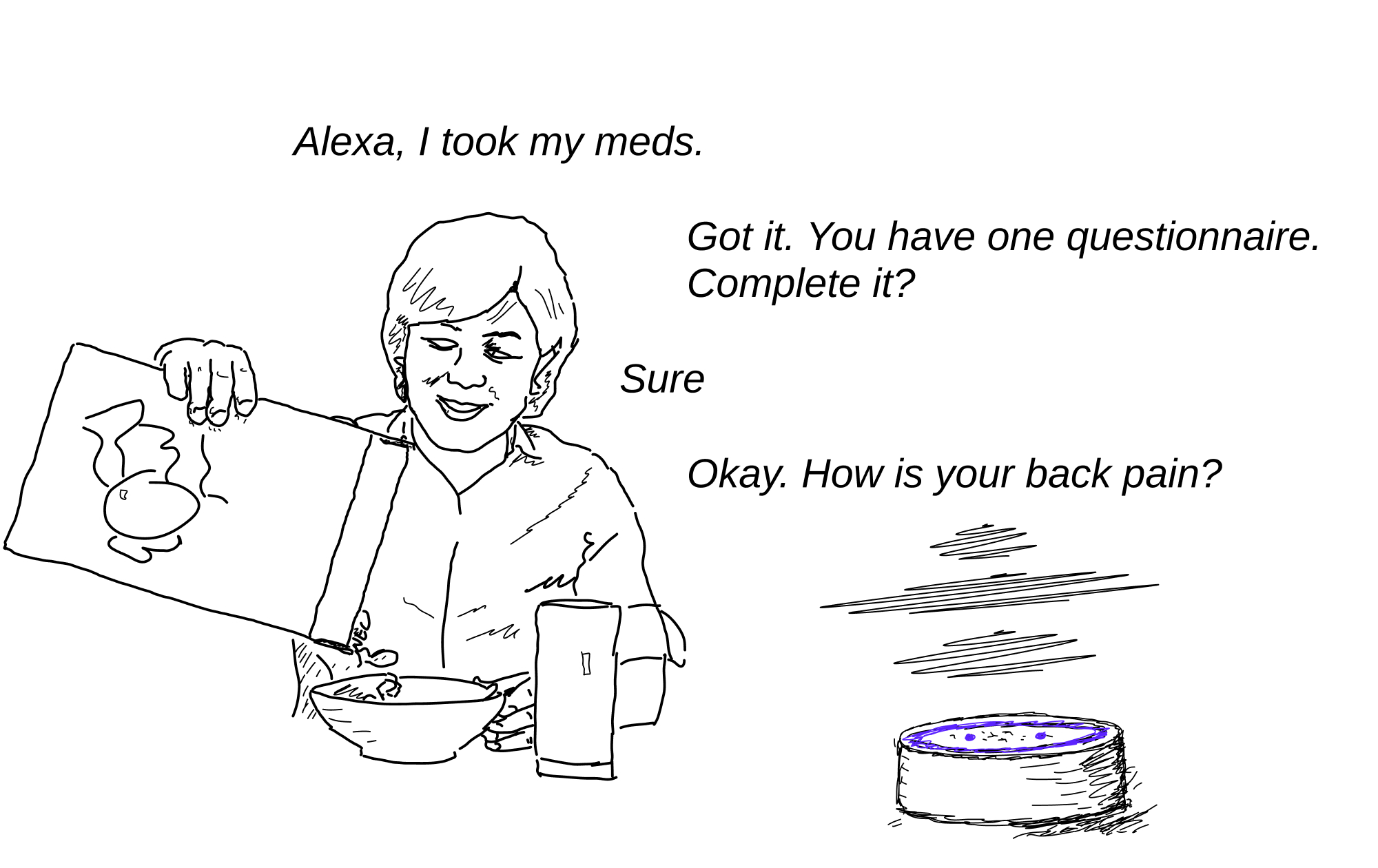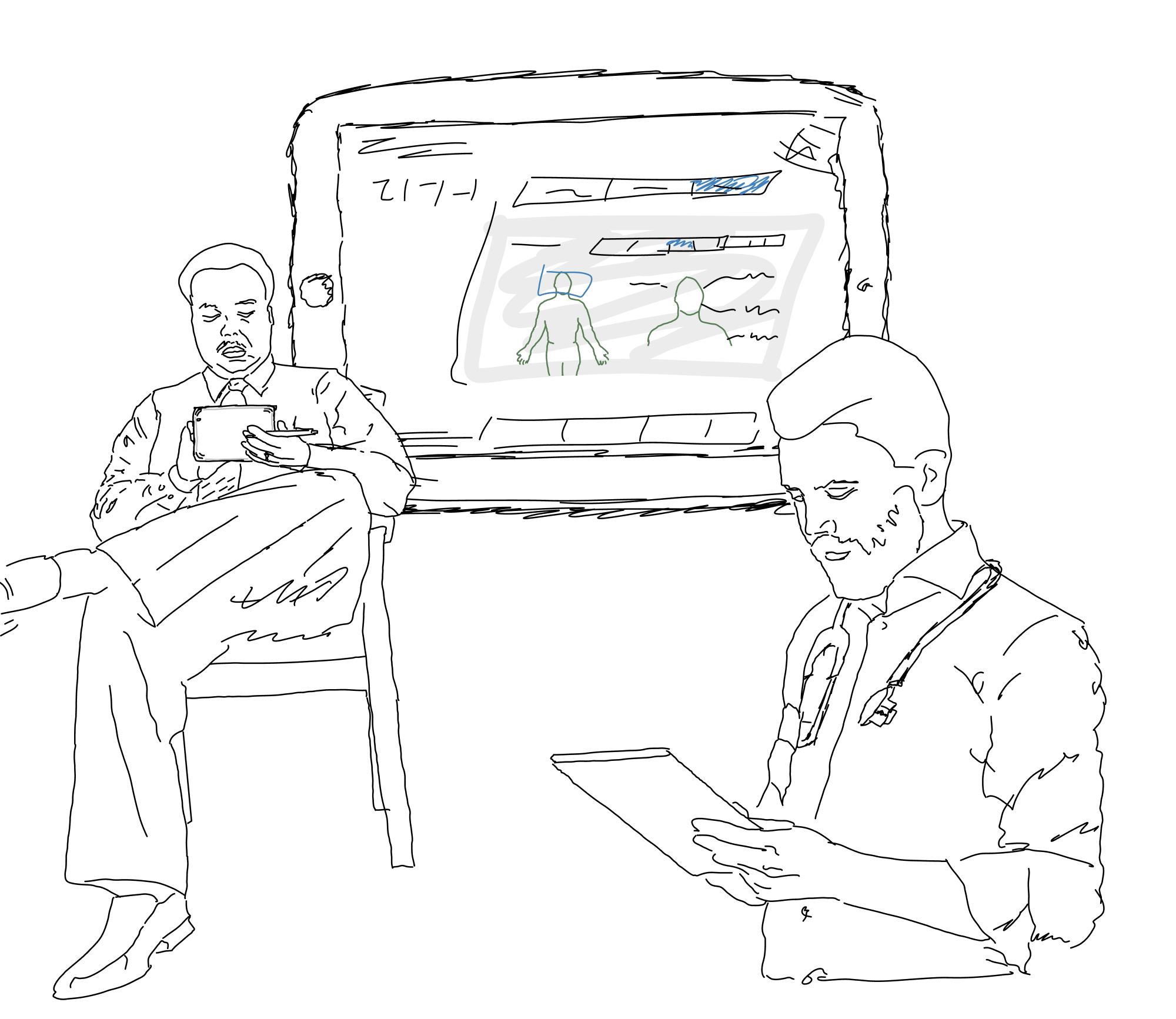
openPRO: Your health. Your voice.
Open source services for patients to capture and report their health outcomes.
True patient-focused care requires listening to the VOICE of the patient herself. As she travels from health to sickness and hopefully back to health again, we must record and value her own words as she describes her pains, her values, and her needs.
What is PRO and why is it important?
Patient-Reported Outcome (PRO): Any report on the status of a patient's health coming directly from the patient without any interpretation or interference.
The Patient-Reported Outcome is the platform for the patient to be heard. Why must we listen?
- Our health system is moving toward focus on quality of care from quantity of care. Quality is measured as a combination of lives saved, readmission, medical outcomes, as well as quality of life measures such as pain and mobility. However, the very words of the patient that define quality in the patient’s interest are too often ignored. We must center our care and attention on the patient’s needs, values, and experiences.
- A curious thing about pain is how easily we forget it after the fact. When, where, how much... these are all important details the doctor wants to know, and we find ourselves struggling to recall, filling in the gaps with maybe- truths. It certainly would be helpful to record pain when it happens, where it happens. At the doctor’s office, that record should already be in the doctor’s hand to be used that much more easily to diagnose and treat the patient.
Your Patient Reported Outcome is a direct connection between you, the source of critical medical data, and the decisions regarding your care and the future of the health system.
The PRO enables...
Improved communication
The patient can initiate communication of relevant medical data with the doctor to send outcomes, align priorities, and arrange the care they need.
Less time on data entry and better time with the patient
The patient records her own experiences and pushes it to the health record. Her doctor can then spend more face-to-face time discussing her care, rather than conducting time-consuming interviews and performing data entry.
Improved quality of treatment
PRO tools allow the patient to report clinically relevant information at the point of pain, when it is most reliable, to inform the most appropriate treatments. Over the course of treatment, the PRO promotes accurate recordings of outcomes to advance changes when needed.
Personalized care
The patient is able choose treatments, personalized to their needs, by drawing on the past successes, experiences, and self-reported outcomes of many similar patients who came before them7,8,10
Improved healthcare for all
The patient provides invaluable data on treatment outcomes. The data is accurate, timely, and multi-dimensional. These qualities of data are possible only with many patients’ voices.
The current landscape
Patient portals offer communication between the patient and care team. Some EHR vendors offer the ability to send PRO questionnaires to patients, and few (e.g. Partners HealthCare) support structured data collection back into the EHR from those questionnaires. However, patient portals have some severe limitations and shortcomings14,15,17 which lead to limited use. Portals are only available to one in two patients, and of the half with access, half again don’t use them. In total, 25% of all patients use portals and under 15% of all patients use them to communicate with their care team.
Patient-reported outcome measures (PROMs) are instruments developed to measure a particular condition or outcome of a patient. They take the form of questionnaires, administered on paper or electronically (ePROMs), consisting of about 10-15 scale based questions. The instruments are heavily vetted and studied5 and accurately collect targeted data and associate that data with clinically relevant measures via a single score. More sophisticated electronic versions use an adaptive format that selects questions in response to answers.
Progress
- Application to patient screening and monitoring1
- Cohort-specific treatment studies and drug trials2,11.
- Queries of populations to identify unmet needs in pharmaceutical development and to align care with the needs of the local patient community8.
- A growing community of initiatives such as SIMPRO and strategic workshops such as the FasterCures 2017 workshop8.
- PROMIS® (Patient-Reported Outcomes Measurement Information System) is a set of person-centered measures that evaluate and monitor physical, mental, and social health. It includes a wide range of measures that have been vetted and studied. The project also supplies administration platforms3,4.
Limitations
- Limited portal integration of PROMs, with few exceptions.
- Siloed stand-alone PRO platforms (LifeData, WellBe, OutcomeMD, Ortech) are poorly connected to the patient’s other health data.
- No data standards, although FHIR PRO promises to ease the implementation and integration into EHRs.
Challenges
- Lack of annotated libraries. Difficult to identify measures appropriate for a particular patient12.
- Patient wariness. Without seeing personal advantages and becoming invested, a patient can be wary of sharing more information via forms.
- Patient weariness. Patients grow tired of filling out forms.
- Lack of resources to administer electronic PROs. Neil W. Wagle, at Brigham and Women’s Hospital in Boston:18
"The platform must also be integrated into the electronic health record (EHR) system so that results flow into the point of care in real time in order to be actionable. And it must work nearly perfectly because neither patients nor providers have the patience for glitches.”
Our solution: openPRO
An open source project capturing the patient’s voice, beautifully and simply.

We’ve conceived several projects seeking to overcome these challenges and push PROs to realize their potential.
- VoicePROM
- Symptom Reporter
- ROS Reporter
- openPRO Platform
The benefits of being open source are three-fold. First, the extended community provides verification, support, and feedback, improving the quality and relevance of the process and product. Second, the mature product will provide services as well as an open source repository of resources, designs, and code for other developers and teams to utilize. Third, the open process has a positive impact on medicine by building community and interest in improving the state of PROs.
1. voicePROM
VoicePROM is a voice-first platform that collects short, scheduled, and structured data from the patient with convenient low-burden methods. The collected elements are drawn from a pre-built set of care-plan adherence measures and standard questionnaire formats
Voice-first solutions in the medical space are making slow but focused progress. Much of this progress is in the clinical documentation realm, allowing clinicians to not only dictate medical notes, but capture the structure data needed in the EHRs by voice (Nuance, Winscribe, and more). These however are confined to the clinic and do not help patients in their home-care and care plan adherence. On the other hand, there are Alexa Skills available that can help with medication reminders or with tracking symptoms, but they do not provide reporting and they are awkward to configure and use. To our knowledge, there are no publically available voice interfaces for collecting PROMs or questionnaires.

Feature roadmap
- Establish and demonstrate voice capture for a fixed set of requests: medication adherence, sleep, daily Quality of Life (QoL) check-in.
- Simple user management and database
- Scheduler and reminder system
- Multimodal input and output (voice, small display, button, etc)
- Web configuration tool to customize reminders and create periodic reports..
- Deliver custom and standard questionnaires to patient.
- Integration into other openPRO products.
- Reports are delivered as FHIR bundles.
Current state: gestating
Using the Alexa and AWS services from the Amazon ecosystem, we’ve developed a simple smart speaker application. The patient reports medication adherence and sleep, and the platform records that data. We are currently working on a scheduling and reminder system to ensure daily reporting and to alert the user if a questionnaire is waiting completion.
Estimated Level of Effort
Minimal Prototype: 8 weeks, 1.0FTE
Design and Development v1.0: 8 weeks, 1.0FTE
2. Symptom Reporter
The Symptom Reporter helps a patient distill and clarify subjective symptoms and experiences into structured data that can be conveniently and consistently shared with clinicians in person, via email/text, or the Electronic Medical Record. Foreign language support will help patients prepare a report in English before an appointment so they can be more comfortable and confident in communicating their experiences and needs.
Similar products exist, but there are important differences. There are many online symptom checking tools (WebMD.com, Isabel symptomchecker.isabelhealthcare.com) that focus on providing a home diagnosis. Symptom trackers are popular mobile apps that allow a patient to keep tabs on a chronic or recurring symptom over time. Neither of these types of application focuses on aiding communication or creating a detailed and medically relevant report at the point of pain. The most similar app available is AHRQuestionBuilder, developed by U.S. Department of Health and Human Services. Some patient portals integrate a symptom checker (Epic - Mayo Clinic’s MyChart), but again, it does not provide any way to begin a conversation with a clinician regarding those symptoms. Hopefully, an open source tool such as openPRO - Symptom Reporter would help encourage such integration.

Goals
- Improve communication between the patient and care team
- Improve fidelity of information by recording events closer to the relevant time and place (point of pain)
- Lower stress on the patient by improving the fidelity of data during transfers of care
- Provide foreign language support within the interface
Components
- Web interface to help identify symptoms and collect relevant information: onset, intensity, location, etc.
- Receipt for the patient in both plain English and medical language for sharing, easy reference, printing, etc.
- FHIR resources enumerating the captured conditions using standard coding schema. This is a first step in importing the data into a health record.
Estimated Level of Effort
Design: 4 weeks, 1.0FTE
Development v1.0: 6 weeks, 1.0FTE
3. ROS Reporter
A review of systems (ROS) is a gathering of targeted medical information such as symptoms from a patient. Reimbursement models push doctors to ask more and more particular sets of questions, consuming precious in-encounter time. In the interest of time, issues that are medically relevant or important to the patient may not be addressed6, creating an incomplete picture from which the doctor assesses and plans treatment.
The ROS Reporter is an interactive web application will allow the patient to submit responses in privacy and comfort outside the encounter, either at home before a visit or while waiting at the office. Some clinics and offices distribute ROS forms, either by paper or electronically to patients when they arrive at reception or by a nurse. These questionnaires have several deficiencies:
- They feel irrelevant. The patient answers in the negative for row after row of questions that are not related to the purpose of the visit. The forms are one-size-fits all.
- They are often tedious and inefficient. Paper questionnaires are often poorly designed and require manual entry into the EHR. Electronic questionnaires are often time consuming as they ask many sequential questions with negative responses.
- The data collected is insufficient. The doctor or nurse asks the relevant questions again, with multiple follow-up questions such as frequency, severity, and timing.

Goals
- Improve communication between the patient and care team
- Improve the fidelity and relevance of information from the patient, by recording events and pains closer to relevant time and place (point of pain)
- Provide designs that minimize survey fatigue and maximize the collection of relevant data.
- Lower stress on the patient and improve the fidelity of data during transfers of care
- Provide language and accessibility support
Components
- Web interface to identify symptoms and collect relevant info (onset, intensity, location, etc.). The questionnaire is responsive and intelligent, focusing on systems and lines of questions relevant to the patient’s conditions.
- Receipt for the patient in both plain English and medical language for sharing, easy reference, printing, etc.
- FHIR resources enumerating the captured conditions using standard coding schema. This is a first step in importing the data into a health record.
Estimated Level of Effort
Design: 4 weeks, 1.0FTE
Development v1.0: 6 weeks, 1.0FTE
4. openPRO Platform
The openPRO web service will offer low-effort administration of PROs for clinicians and patients. Any party can, ad hoc, initiate a PRO. The patient sends to the doctor via the service a de-identified PRO, which is assigned to the patient using separate established secure channels. The clinic can then insert the new data in the EHR, either by hand or by an import function implemented at the clinic’s side.
Goals
- Empower patients to administer and initiate their own PROs and PROMs.
- Make administration and completion of PROs more convenient for both patients and administrative staff.
- Satisfy patient privacy by anonymizing the communication of the data. The data is then associated with the patient’s identity within the office’s established secure system.
- Provide a platform for distributing the Symptom Identifier, ROS reporter, and Voice PROMs.

Components
- Front-end services:
- Website for requesting, completing, and receiving PROs
- Request interface
- Request a PRO to be filled out by self or other
- Receive a unique key that identifies the incomplete PRO
- PRO/questionnaire is one of: custom designed questionnaire, established questionnaire from PROM library (PROMIS), openPRO product such as ROS capture or Symptom Reporter
- Capture interface
- User submits unique key to access and complete PRO
- Provide interface to complete custom questionnaire
- Provide interfaces from PROMIS or openPRO tools
- View interface
- User submits unique key to view or download completed PRO
- Visualization tools for questionnaires, Symptom Reporter, and ROS Reporter.
- Ability to produce associated FHIR Condition resources from questionnaires
- Back-end services:
- Key manager. Generates, distributes, and processes keys associated with incomplete and complete PROs
- Storage for pending and complete PROs.
- SMART on FHIR app that fetches the anonymous responses and attaches the patient’s identity to the PRO for insertion into EHR.
Estimated Level of Effort
Design: 3 weeks, 1.0FTE
Development of minimal service: 6 weeks, 1.0FTE
Authors
Contributors
References
- Basch, Ethan, Allison M. Deal, Amylou C. Dueck, Howard I. Scher, Mark G. Kris, Clifford Hudis, and Deborah Schrag. 2017. “Overall Survival Results of a Trial Assessing Patient-Reported Outcomes for Symptom Monitoring During Routine Cancer Treatment.” JAMA 318 (2): 197.: https://doi.org/10.1001/jama.2017.7156
- Bottomley, Andrew, Dave Jones, and Lily Claassens. 2009. “Patient-Reported Outcomes: Assessment and Current Perspectives of the Guidelines of the Food and Drug Administration and the Reflection Paper of the European Medicines Agency.” European Journal of Cancer (Oxford, England: 1990) 45 (3): 347–53.: https://doi.org/10.1016/j.ejca.2008.09.032
- Broderick, Joan, Esi Morgan DeWit, Nan Rothrock, Paul Crane, and Christopher B. Forrest. 2013. “Advances in Patient Reported Outcomes: The NIH PROMIS Measures.” EGEMs (Generating Evidence & Methods to Improve Patient Outcomes) 1 (1): 12.: https://doi.org/10.13063/2327-9214.1015
- Cella, David, Susan Yount, Nan Rothrock, Richard Gershon, Karon Cook, Bryce Reeve, Deborah Ader, et al. 2007. “The Patient-Reported Outcomes Measurement Information System (PROMIS): Progress of an NIH Roadmap Cooperative Group during Its First Two Years.” Medical Care 45 (5 Suppl 1): S3–11.: https://doi.org/10.1097/01.mlr.0000258615.42478.55
- Chu, Dominic, Marko Popovic, Edward Chow, David Cella, Jennifer L Beaumont, Henry Lam, Jasmine Nguyen, et al. 2014. “Development, Characteristics and Validity of the EORTC QLQ-PR25 and the FACT-P for Assessment of Quality of Life in Prostate Cancer Patients.” Journal of Comparative Effectiveness Research 3 (5): 523��–31.: https://doi.org/10.2217/cer.14.41
- Chung, Arlene E, and Ethan M Basch. 2015. “Incorporating the Patient’s Voice into Electronic Health Records through Patient-Reported Outcomes as the ‘Review of Systems.’” Journal of the American Medical Informatics Association 22 (4): 914–16.: https://doi.org/10.1093/jamia/ocu007
- Greenhalgh, Joanne, Sonia Dalkin, Kate Gooding, Elizabeth Gibbons, Judy Wright, David Meads, Nick Black, Jose Maria Valderas, and Ray Pawson. 2017. Functionality and Feedback: A Realist Synthesis of the Collation, Interpretation and Utilisation of Patient-Reported Outcome Measures Data to Improve Patient Care. Health Services and Delivery Research. Southampton (UK): NIHR Journals Library.: http://www.ncbi.nlm.nih.gov/books/NBK409450/
- Grossman, Cynthia. 2018. “Patient-Reported Outcomes: Design with the End in Mind.” Milken Institute.: https://www.fastercures.org/reports/view/70
- “Guidance for Industry. Patient-Reported Outcome Measures: Use in Medical Product Development to Support Labeling Claims.” 2009. U.S. F.D.A.: https://www.fda.gov/downloads/drugs/guidances/ucm193282.pdf
- Hostetter, Martha, and Sarah Klein. n.d. “Using Patient-Reported Outcomes to Improve Health Care Quality.” The Commonwealth Fund. Accessed March 13, 2019.: https://www.commonwealthfund.org/publications/newsletter-article/using-patient-reported-outcomes-improve-health-care-quality
- Marquis, Patrick, Martine Caron, Marie-Pierre Emery, Jane A. Scott, Benoit Arnould, and Catherine Acquadro. 2011. “The Role of Health-Related Quality of Life Data in the Drug Approval Processes in the US and Europe: A Review of Guidance Documents and Authorizations of Medicinal Products from 2006 to 2010.” Pharmaceutical Medicine, May.: http://link.galegroup.com/apps/doc/A260691605/AONE?sid=googlescholar
- “Patient Reported Outcomes FHIR Implementation Guide.” n.d. Accessed March 13, 2019.: http://build.fhir.org/ig/HL7/patient-reported-outcomes/index.html
- “Patient-Reported Outcome.” 2019. Wikipedia.: https://en.wikipedia.org/w/index.php?title=Patient-reported_outcome&oldid=883919582
- Patel, Vaishali, and Christian Johnson. 2018. “Individuals’ Use of Online Medical Records and Technology for Health Needs.” ONC Data Brief 40. The Office of the National Coordinator for Health Information Technology.: https://www.healthit.gov/sites/default/files/page/2018-03/HINTS-2017-Consumer-Data-Brief-3.21.18.pdf
- “Patient Portals Suck.” n.d. Klara - Secure Medical Patient Communication. Accessed March 14, 2019.: https://klara.com/blog/patient-portals-suck
- “PROMIS.” n.d. PROMIS® (Patient-Reported Outcomes Measurement Information System). Accessed March 13, 2019.: http://www.healthmeasures.net/explore-measurement-systems/promis
- Vesely, Rebecca. 2018. “Why Are Patient Portals Such Duds?” Association of Health Care Journalists (blog). August 6, 2018.: https://healthjournalism.org/blog/2018/08/why-are-patient-portals-such-duds/
- Wagle, Neil W. 2017. “Implementing Patient-Reported Outcome Measures (PROMs).” NEJM Catalyst. October 12, 2017.: https://catalyst.nejm.org/implementing-proms-patient-reported-outcome-measures/
- “Web-Based System for Self-Reporting Symptoms Helps Patients Live Longer.” 2017: https://www.asco.org/about-asco/press-center/news-releases/web-based-system-self-reporting-symptoms-helps-patients-live



